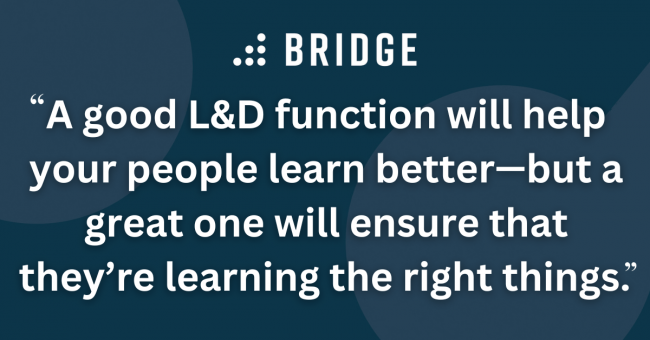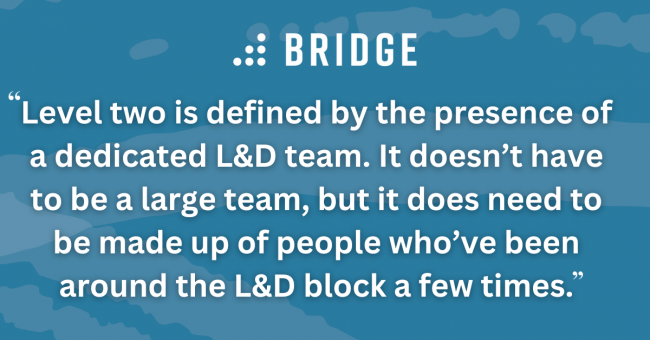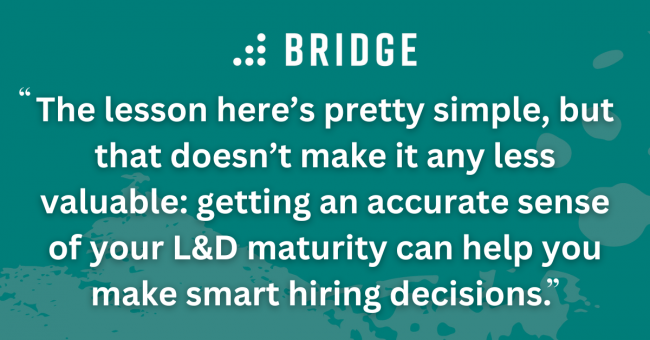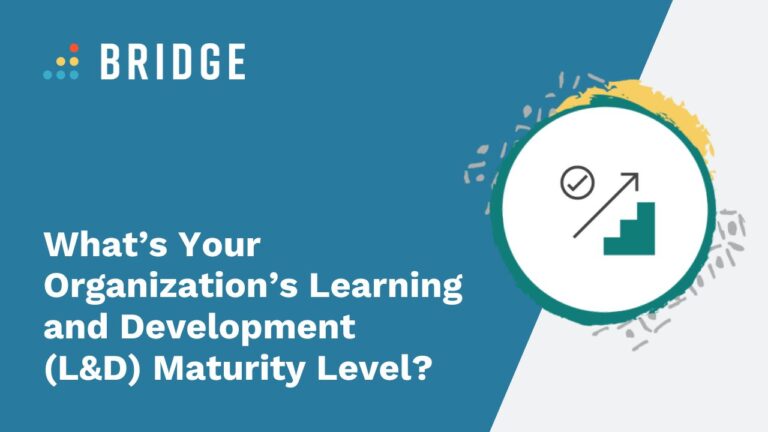To some of our customers here at Bridge, learning and development (L&D) doesn’t necessarily come from an L&D department. We often encounter smaller and mid-size organizations whose HR teams act as a one-stop shop for everything from compliance training to skill development—and that’s a completely normal place to begin.
But as your organization starts to grow, and as you start to think about intentional strategies for supporting employee upskilling and reskilling, how do you know when the time’s right to develop a full-fledged L&D function? What’s the tipping point that leads to your first L&D hire?
While you’re unlikely to be hit with a sudden bolt of realization the moment your organization requires L&D support, there absolutely are ways to assess and act on your level of L&D maturity. Whether you’re looking to uncover your current maturity stage or you want to know how you can actively grow your L&D capabilities, it all starts by understanding what the different levels of L&D maturity look like.
To help you reflect on your current and future L&D needs, we’ve drawn together:
- A way to define L&D’s function in your organization
- A reputable framework for reflecting on your organization’s maturity stage
- A set of tips on when to hire for L&D, the roles you might hire for, and where you might position an L&D team within your organization

Looking Beyond HR: What Does Learning and Development Do?
You might already have a handle on the broad strokes of what L&D entails. Still, if your organization relies on its HR team to handle learning-related tasks, it’s worth taking a moment to remind ourselves of what a dedicated L&D function brings to the table.
According to Bridge-sponsored research, respondents reported that learning is driven by a few key factors:
- 62% cited employee career development as a key factor
- 49% named new skills development among their most important drivers
- 47% pointed to increased employee engagement
L&D teams help to achieve these outcomes in both a micro and a macro sense.
In the former case, your L&D team will be able to devote some serious time and energy to helping employees learn, grow, and develop. In its day-to-day operations, your team will cultivate both the content and the culture required for employee learners to flourish.
It’s not just about the day-to-day. When it comes to the macro side of L&D, you can expect your team to identify the big-picture learning priorities of your organization, ensuring that your workforce is developing in ways that align with business leaders’ strategic objectives.
If you want to sum it up succinctly, you could say that a good L&D function will help your people learn better—but a great one will ensure that they’re learning the right things.
Defining the Stages of Learning and Development Maturity
Plenty of organizations have their own understanding of what L&D maturity looks like, and there’s no universally accepted framework for defining or assessing your organization’s employee development roadmap.
That said, the High-Impact Learning Organization (HILO) Maturity Model from industry analyst Josh Bersin offers a robust, research-backed maturity framework. It’s over a decade old at this point, but it’s still a fantastic way to get a sense of where your organization’s L&D capabilities currently sit—and what the next level looks like.
So, what are the four levels outlined by the HILO model? Let’s find out.
Level 1: Ad-Hoc Approaches to Employee Training and Learning
Every organization will incorporate some kind of learning into its operations. Your onboarding training might be as simple as getting someone to show your new hire the ropes, but it still absolutely counts as incidental training.
While incidental training is a useful way to get across essential information directly from those doing the work, it’s not a sustainable approach in the long term—especially as your organization grows. Without tooling, documentation, guidelines, and so on, you’ll find that the training your employees receive can be non-existent at worst and inconsistent at best. Plus, it’ll be delivered by people who aren’t trained in L&D principles, and who most likely have other (and more productive!) things to do with their time.
Once you’re feeling the effects of this inefficiency, you might just find yourself drawn toward a more reliable learning strategy—which takes us to the second level of the HILO model.

Level 2: Developing a Learning and Development Function
According to the HILO framework, the second level is a multi-facited stage. While level two organizations can spend years incubating their L&D function, there’s one quality they share: they all have an L&D function.
In other words, level two is defined by the presence of a dedicated L&D team. It doesn’t have to be a large team—it could even be a single person—but it does need to be made up of people who’ve been around the L&D block a few times.
At this stage, you’ll want to equip your new L&D team with the digital learning tools they need to deliver learning programs. This can begin with something as simple as a formal eLearning program supported by a corporate learning management system.
As you continue to refine your L&D function within level two, the HILO model suggests that you’ll want to supplement your training tech with a performance management system and embedded learning tools—things like mobile apps and video training platforms. The Annual L&D Benchmark Report 2023 tells much the same story, pointing out that more mature organizations tend to have more advanced technology and infrastructure.
With the right team combined with the right technologies, your L&D function will mature to the point that you’ll be able to deliver standardized instructional design (especially if your expanded suite of supporting technologies includes a course authoring tool).
Level 3: Prioritizing Employee Development and Talent Management
At the third stage of L&D maturity, Bersin’s model notes a shift toward a slightly different direction. Level three isn’t about a change in the amount of training offered, but the kind of training you’ll start to deliver.
As such, mature L&D departments will comprehensively integrate their learning activities with employee development programs. This is as much an attitude shift as it is a practical change. To a level three organization, learning isn’t just a way to improve employee competencies—it’s a key tool for career progression and internal mobility.
This doesn’t mean you should wait for your function to mature before you start aligning employee learning with job roles and career development paths. With the right tools, it can be pretty straightforward to align your learning-based upskilling with job roles and skills expectations.
That said, when your fully-grown learning function starts to interact and align with talent management, that’s when you know you’ve hit a homerun—which means you’re well on your way to level three.
LEARN MORE ABOUT EMPLOYEE MOVEMENT | ‘Internal Mobility vs Talent Mobility: Here’s the Difference (And Why It Matters)’
Level 4: Contributing to Business Strategy Via Organization-Wide Development
In Bersin’s description of the HILO model, level four is about turning your L&D function into the role of a “performance consultant.”
It’s a stage characterized by taking a broader view of your workforce’s diverse array of needs and building a case for capability-building activities on an organization-wide scale, allowing L&D to better support business priorities and strategies.
The HILO model isn’t alone in this assessment, either. According to the Annual L&D Benchmark Report 2023, the most mature organizations (in L&D terms) have significantly better capabilities to support:
- Performance consulting
- Leveraging L&D expertise
- Strategy and governance
These qualities might be a bit of a north-star vision for early-stage L&D functions, but—as with any other objective—it’s helpful to have a sense of the end-goal.
When to Hire Learning and Development Employees (Rather Than Relying on HR!)
Every organization will mature at its own pace, so it’s important to take maturity models like HILO as guidebooks, not Bibles. That said, Bersin’s framework does give us a rule of thumb as to when you should look to make L&D hires.
When you’re noticing what Bersin and associates call the “inconsistent, expensive, and unproductive” nature of ad hoc training, you’ll be looking to transition to level two. And, as we know, level two starts with a dedicated L&D professional or team of professionals that can help you scale your training and development efforts.
So, what does that team look like? Let’s find out.

Getting the Timing Right for Your Learning and Development Hires
Again, paying attention to your L&D maturity level is a great way to inform your hiring decisions. It’ll alert you to the need for a more developed team—and it’ll also prevent you from making hires before they’re strictly necessary.
This latter point is important to bear in mind, especially given the hiring trend we’ve noticed among organizations that are still in the early stages of developing a learning capacity. These organizations will typically leave the bulk of their L&D activities to their HR teams, but they’ll supplement those efforts by bringing in an LMS administrator.
It might feel like this is a sensible move, especially for organizations looking to get serious about training and development. However, we often find that these LMS admin positions are among the first to get cut in the face of budgetary squeezes.
There’s a good reason for this. If your organization isn’t large enough to warrant a more mature L&D infrastructure, your LMS can more or less run itself. When it’s set up in the right way, you can easily introduce automation to things like enrollment processes—and with the right support from your vendor, even integrating your LMS with other tools can be fairly seamless. In other words: at a lower maturity level, your learning tech doesn’t necessarily need much oversight.
For larger organizations with a more developed L&D capability and a bigger workforce to train, it’s a different story. When you have 50 authors in the tool, you’ll need a dedicated LMS admin to clean up these vast volumes of content, constantly evaluate roles and permissions, and liaise with IT. The lesson here’s pretty simple, but that doesn’t make it any less valuable: getting an accurate sense of your L&D maturity can help you make smart hiring decisions.
How Does L&D Maturity Impact the Size of Your L&D Team?
In the broadest sense, it’s fair to assume that a more mature L&D function will need to be supported by a larger team.
In the HILO model, transitioning from a level one to a level two maturity stage is accompanied by the general growth of your organization. That will probably mean you’ve got a larger workforce which, in turn, will have more training needs—leading to a bigger L&D team to handle those needs.
2023 research from the Chartered Institute of Personnel and Development (CIPD) supports this idea, too. According to the CIPD’s Learning at Work Survey, larger organizations are more likely to prioritize the process of linking learning to performance and organizational development. These priorities correspond to levels two and four of the HILO maturity model—and they’d likely require larger L&D teams for effective implementation.
On the other hand, it’s worth noting that even in large organizations, L&D teams can still be fairly small—especially when they’re supported by the right technologies. With an integrated LMS and performance management system, it’s possible to take the mature step of linking learning and performance (for example) with just a handful of L&D practitioners.
MORE FROM THE BLOG | ‘Rolling Out Your Performance Management System: 3 Critical Factors to Consider’
How Do You Structure a Learning and Development Team?
Let’s say your L&D function has matured to the point that you’re assembling a full-fledged L&D team. As we’ve seen, the size of that team can vary—but what roles or positions might different members of your L&D hierarchy hold?
Your L&D team could include senior figures like a learning and development manager, a head of learning and development, or even a director of learning and development. Lower down the L&D chain of command, you might maintain figures like instructional designers, training deliverers, and learning administrators.
There’s some debate as to whether an L&D team should be entirely centralized or whether there’s scope for decentralization—especially when it comes to supporting the specialized learning requirements of individual units or departments.
But when you’re just starting out on the path to L&D maturity, you’ll definitely want to maintain a centralized L&D function. This core group of learning professionals will be able to introduce those all-important consistencies to global learning requirements like onboarding, compliance training, and establishing your company culture.
Grow Your L&D Skills and Capabilities With Bridge
No matter what stage of maturity your L&D function is currently at, you’ll effortlessly expand the scale and quality of your employee development efforts with the help of Bridge’s LMS (Bridge Learn) and performance management system (Bridge Perform), available as standalone products or as a single, all-in-one offering. Get in touch or request a free trial to (literally) take your learning function to the next level.




